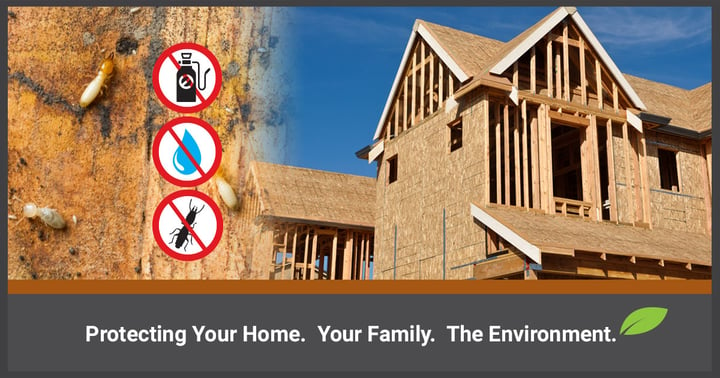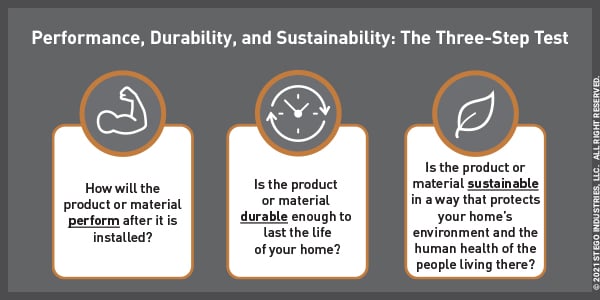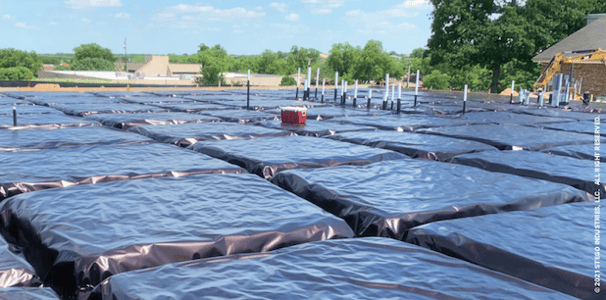How to Protect your Dream Home from Termite Attack without Harming the Environment with Pesticides
For Sustainable Custom Home Building, Put Every Material in its Construction to this 3-Step Test
Termites are a nightmare. But if you are building a custom home, they do not have to keep you up at night.
There is a wonderful exercise which people can use to fall asleep: imagine your dream home. Walk around the lot; is it on the beach? In the mountains? On a lake or a farm? Walk in the front door. Take time to look at every room, every piece of furniture, every fixture.
If the exercise works for you, you will never make it through the entire house before falling asleep. Allowing the mind to visualize something positive and relaxing can push out the anxiety and stresses that cause sleepless nights.
This is not just a meditation exercise. If you are in the process of building that house in the real world, there is also a practical lesson that can help avoid building nightmares – like subterranean termites.

By understanding this phenomenon, you have also unlocked the marketing power of every realtor, custom home builder, and do-it-yourself home improvement store. They all, quite literally, want you to dream. Walk into their storefronts, showrooms or warehouses and the pretty fixtures, lights and aesthetics are all in the front. The practical stuff – lumber, pipes, toilets – that’s “in the back somewhere” if you are lucky enough to find an associate who can help you find it.
As the product manager of a highly engineered physical termite barrier, I know this back section is where the important decisions get made and where knowledgeable custom home builders do their best work: selecting the building materials and components that deliver the greatest performance, durability and sustainability for the life of your dream home.
If you are fortunate enough to be in the position to turn that custom home dream into a reality, try this same mental exercise with your custom home builder. Walk past the pretty light fixtures, sparkling countertops, and gleaming floor covering choices in the showroom and put every material that goes into your project to this three-step test.

1) How will the product or material perform after it is installed.
2) Is the product or material durable enough to last the life of your home?
3) Is the product or material sustainable in a way that protects your home’s environment and the human health of the people living there?
Let’s take this three-step test and apply it to termite treatment/mitigation options you might consider before you start your dream home build.
Example #1: Spray Foam Insulation
✔ Its performance is undeniable
✔ Its durability is average
❌ Its sustainability is awful.
Example #2: Chemical Termiticide Pretreatments
✔Its performance is fine until...
❌ Its awful durability leaves your home at risk. You will need reapplication of the pesticide at regular intervals for the life of the building.
❌ Its sustainability is abominable, and we have known this for decades. It can lead to soil and water pollution along with to people, pets and other wildlife.
Example #3: Physical Termite Barrier
✔ Its performance is great where it is applied
✔ Its durability typically is tremendous.
✔ Its sustainability is terrific when contrasted with chemical termiticides.
What is the Sustainable Prescription for Termite Prevention Options?
If you are building your home in an area where subterranean termites are a concern, the most common preventative strategy in most parts of the country is to saturate the soil under your home with a chemical termiticide. This practice is called a soil treatment.
Perhaps it goes without saying, but saturating the soil underneath and around your home with chemical pesticides is not in line with modern green building practices and standards
There are numerous green building standards in use today. LEED (Leadership in Energy and Environmental Design), National Green Building Standard (NGBS), The WELL Building Standard and The Living Building Challenge, just to name a few. The ins and outs of these standards all have a common theme build sustainably and minimize the environmental impacts of construction.
When it comes to subterranean termite protection, eliminating or drastically reducing the use of chemical pesticides/termiticides is the goal of these standards. Pretreating the soil with chemical termiticides risks exposure to people, pets, non-target species, pollutes the soil and potentially our waterways. What then is the prescription for subterranean termite prevention that aligns with the requirements of our green building standards and responsibly will provide effective protection? Certainly, doing nothing and crossing your fingers is not a gamble you should be taking.
Take a Look at the Whole Subterranean Termite Picture with IPM Strategy
The basis for any “green” approach to subterranean termite protection starts with the concept of Integrated Pest Management. While there is no official definition of IPM, the EPA does a great job of summarizing the principals and states the following:
“IPM programs take advantage of all appropriate pest management strategies, including the judicious use of pesticides. Preventive pesticide application is limited because the risk of pesticide exposure may outweigh the benefits of control, especially when non-chemical methods provide the same results.”
Note that the EPA recognizes that pesticides have their place in pest management. As it pertains to subterranean termites, if there is an active infestation within your home, pesticides may be the only practical means with which to eradicate these pests and save your home from further destruction
What the EPA, the various green building standards and IPM in general are advocating is that equally effective, non-chemical preventative measures before during a new home construction process. Product selection plays a big role here as do design elements that can be built into the structure which can effectively replace the use of pesticides in a pre-treatment capacity.
IPM takes into account the whole picture of preventative measures to protect against subterranean termite attack The cornerstone of any IPM strategy for termite protection is the installation of a proven physical termite barrier under the slab or within the crawl space. This layer of protection is your primary defense.
Simple Tips on How to Make Your Attractive New Home Less Attractive to Subterranean Termites
After a physical termite barrier, a good IPM strategy provides concentric circles of protection by making your home a less attractive target for subterranean termites. Simple landscaping choices and basic habitat manipulation will serve to make your home beautiful to the human eye, while at the same time making it uninviting to foraging subterranean termites.
.png?width=600&name=2021%20STEGO%20INDUSTRIES%20LLC.%20ALL%20RIGHTS%20RESERVED.%20(1).png)
For example:
- Problem: Mulch and shrubbery placed up against your home may be aesthetically pleasing but provides an ideal habitat for subterranean termites.
- Solutions:
- Choosing non-cellulose based materials (i.e. rock) to be placed against the exterior of your foundation is great option.
-
- Don’t despair, curb appeal does not need to be compromised to adhere to an IPM subterranean termite plan. By keeping plants/shrubs at least 4 feet away from the foundation you will retain the curb appeal while not attracting foraging termites.
Protecting Your Custom Home from Termite Attack Without Harming the Environment
Respecting the environment and minimizing exposure to harmful chemicals are at the heart of sustainable building practices. These principles should be a priority for any new construction project, whether you are seeking certification from LEED, a rating from NGBS, or are simply wanting to be good stewards of our land and water.
Fortunately, there are effective and cost efficient physical termite barriers available today which do not contain any chemical termiticides. Protecting your home from subterranean termite attack no longer requires a compromise of polluting soil and water while endangering your health and other wildlife.
Your lifetime of hard work and saving has led you to this point where your custom dream home is now becoming a reality. Making aesthetic choices and selecting the design features you’ve always wanted are the fun parts of this process, and they’ll be waiting for you right at the front of the showroom at your local superstore.
But make sure you also put due diligence into all the building materials and processes that live at the back of the store, too. These critical choices are what ensure your dream home will function as intended and last a lifetime.
By incorporating a physical termite barrier under-slab or within your crawl space, you help ensure the structural integrity of your home will not be compromised by termite attack and eliminate or reduce the amount of chemical pesticide exposure to your family, pets and the environment.

Written by Ryan Goodwin
Ryan Goodwin is the Pango® Product Manager at Stego Industries, LLC. He has been a part of the Stego team for over fifteen years with previous roles as the Regional Manager and Regional Director for Texas, Oklahoma, and Louisiana. As the Pango Product Manager, Ryan was a part of the team that developed Pango Wrap. Ryan appreciates working with design professionals, pest management professionals, and contractors to promote Integrated Pest Management practices and sustainable solutions for pest control.
- Stego (26)
- StegoCrawl (24)
- Stego-Awareness (17)
- StegoHome (15)
- Case Studies (14)
- StegoCrawl-Consideration (12)
- StegoCrawl-Awareness (11)
- Customer Stories (9)
- Stego-Consideration (9)
- Pango (8)
- StegoHome-Consideration (8)
- Beast (7)
- How to Install (7)
- StegoHome-Awareness (7)
- Drago (5)
- Pango-Awareness (5)
- Beast-Awareness (4)
- Beast-Consideration (3)
- Drago-Awareness (3)
- Pango-Consideration (3)
- Stego IQ (3)
- Drago-Consideration (2)
- StegoCrawl-Decision (2)
Popular Posts
Stay Connected.
Enter your email below.








Post Comments